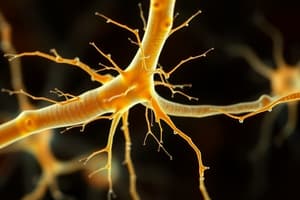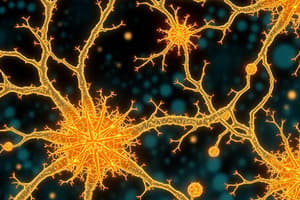Podcast
Questions and Answers
What occurs when the NMDA receptor opens due to depolarization and glutamate binding?
What occurs when the NMDA receptor opens due to depolarization and glutamate binding?
- An influx of K+ ions
- A decrease in synaptic strength
- An influx of Ca²+ ions (correct)
- An influx of Na+ ions
The phrase 'fire together, wire together' refers to how active pre- and post-synaptic neurons strengthen their synaptic connections.
The phrase 'fire together, wire together' refers to how active pre- and post-synaptic neurons strengthen their synaptic connections.
True (A)
What is the role of dopamine in persistent long-term potentiation (LTP)?
What is the role of dopamine in persistent long-term potentiation (LTP)?
It activates gene transcription and protein synthesis in the postsynaptic cell.
During tetanic stimulation in the hippocampus, a __________ frequency electrical signal is used to induce LTP.
During tetanic stimulation in the hippocampus, a __________ frequency electrical signal is used to induce LTP.
Match the following terms with their descriptions:
Match the following terms with their descriptions:
Which type of neuron is characterized by having axonal projections to the soma and exhibiting a fast spiking pattern?
Which type of neuron is characterized by having axonal projections to the soma and exhibiting a fast spiking pattern?
Regular spiking neurons are capable of showing high frequency spiking.
Regular spiking neurons are capable of showing high frequency spiking.
What are the two major functions of the AIS in neurons?
What are the two major functions of the AIS in neurons?
Calcium binding protein important in some inhibitory neurons is called __________.
Calcium binding protein important in some inhibitory neurons is called __________.
Match the following types of neurons with their features:
Match the following types of neurons with their features:
Study Notes
AIS Localization and Function
- The Axon Initial Segment (AIS) is crucial for action potential firing and maintaining neuron polarity.
Electrophysiology Classification
- Regular spiking: Neurons exhibit regular spiking even with large current injections, but they do not show high-frequency spiking.
- Fast spiking: Neurons are capable of high-frequency spiking (hundreds of spikes per second) and do not show adaptation.
Molecular Classification of Inhibitory Neurons
- Basket cells: Project to the soma and peri-somatic regions, express Parvalbumin (PV), and have a fast-spiking firing pattern.
- Axo-axonic cells (chandelier cells): Project to the initial segment of axons, express Parvalbumin (PV), and have a fast-spiking firing pattern.
- Distal dendrite targeting cells: Project to distal dendrites, express Somatostatin (SOM), and have a regular spiking pattern.
- Interneuron projection cells: Project to inhibitory neurons, express Vasoactive intestinal peptide (VIP), and have a regular spiking pattern.
The Neuron Doctrine and Synaptic Communication
- The neuron doctrine states that individual neurons are the fundamental units of the nervous system.
- Synapses are structures where neurons communicate with each other.
- The phrase "fire together, wire together" describes the Hebbian synapse, where coincident activity strengthens the connection between neurons.
- NMDA receptors are crucial for Hebbian plasticity.
- At rest, Mg²⁺ ions block NMDA receptors.
- Depolarization by AMPA receptor activation removes Mg²⁺ ions, allowing NMDA receptors to open upon glutamate binding.
- NMDA receptor activation leads to Ca²⁺ influx, which triggers changes in synaptic properties.
NMDA Receptor-Dependent LTP
- Glutamate release from the presynaptic neuron activates postsynaptic AMPA receptors, depolarizing the postsynaptic neuron and opening NMDA channels.
- This influx of Ca²⁺ into the postsynaptic neuron initiates protein phosphorylation of AMPA receptors.
- This increases AMPA receptor conductance and leads to the insertion of new AMPA receptors, strengthening the synapse.
Persistent LTP
- Dopamine activation of dopamine receptors is required for persistent LTP, which involves gene transcription and protein synthesis in the postsynaptic cell.
- Persistent LTP requires coincident activity in both the pre- and post-synaptic neurons, allowing for NMDA receptor activation and Ca²⁺ influx leading to synaptic strengthening.
LTP Research Techniques
- Tetanic stimulation is used to investigate LTP.
- Stimulating electrodes are placed near the axons of the neurons under study to induce LTP, while recording electrodes near the cell bodies record the responses.
- High-frequency electrical signals are delivered to the stimulating electrode to induce LTP.
- The data shows an increased and sustained response after tetanic stimulation, representing LTP.
Summation: Linear and Non-linear
- Linear summation assumes that the sum of multiple EPSPs is equal to their individual magnitudes.
- In biology, non-linear summation often occurs due to voltage-gated ion channels and the non-linear effects of multiple channel opening.
- Supralinear summation occurs when the combined EPSP is greater than the sum of individual EPSPs.
- Sublinear summation occurs when the combined EPSP is smaller than the sum of individual EPSPs.
GABA Shunting as an Example of Non-linear Summation
- IPSPs are not visible at resting membrane potential, but GABA receptors are still open and can affect other PSPs.
- GABA receptors can shunt depolarizing current from EPSPs, leading to a smaller combined effect, illustrating non-linear summation.
Layer-Specific Connections in Neocortex
- Neocortex is organized into six layers with distinct populations of neurons.
- Neurons in different layers are connected in a specific manner.
- Extensive research is needed to completely understand the connections between different cell types and layers in neocortex.
Thalamo-Cortical (Feedforward) Projections
- Thalamo-cortical projections originate in the thalamus and project to both deep cortical and subcortical nuclei.
Local mRNA Translation and Protein Synthesis
- CaMKll, a protein involved in LTP, is locally synthesized in dendritic regions.
- CaMKll mRNA is transported to the synapse and translated, allowing for localized production of CaMKll proteins.
- This process also occurs for other synaptic proteins involved in LTP.
Advantages of Local Protein Production
- Cost of transport: One mRNA molecule can produce many proteins, reducing the cost of transport.
- Improved protein targeting: Local production minimizes protein loss and misdirection.
- On-demand protein synthesis: Local synthesis provides a rapid response to synaptic activity.
Neural Recording Methods
-
Single cell activity recordings:
- Extracellular recording: Recording outside the cell, capturing a low-amplitude signal that needs amplification.
- Intracellular recording: Recording inside the cell.
- Sharp electrode: A sharp electrode penetrates the cell membrane.
- Patch clamp: A tight seal between the electrode and the cell membrane allows for recording of specific membrane currents.
- Optical recording:
- Calcium signal recording: Recording changes in intracellular calcium concentration.
- Voltage signal recording: Recording changes in membrane potential using voltage-sensitive dyes.
-
Large-scale recordings:
- fMRI (functional magnetic resonance imaging): Detects blood flow changes associated with neuronal activity.
- MEG (magnetoencephalography): Detects magnetic fields generated by neuronal activity.
- EEG (electroencephalography): Records electrical activity in the brain from the scalp.
- NIRS (near-infrared spectroscopy): Detects changes in blood oxygenation levels related to neuronal activity.
- Ultrasound imaging: Uses sound waves to create images of brain structures and activity.
Optogenetic Stimulation
- Optogenetic stimulation uses light-sensitive channel rhodopsin to control neuronal activity.
- Rhodopsin's reversal potential determines whether light stimulation causes depolarization or hyperpolarization.
Molecular Mechanisms of LTP
- Early LTP: CaMKII-induced phosphorylation of AMPAR and their movement to the membrane, increasing the number of AMPAR.
- Late LTP: The CREB system activates RhoGTP, which in turn triggers transcription of actin, leading to spine growth.
Short-Term Plasticity
- Short-term plasticity is cell-type specific and can vary depending on the connection between neurons.
Important Terms
- EPSP (excitatory postsynaptic potential): A depolarizing potential that makes the postsynaptic neuron more likely to fire.
- IPSP (inhibitory postsynaptic potential): A hyperpolarizing potential that makes the postsynaptic neuron less likely to fire.
- AMPAR (α-amino-3-hydroxyl-5-methyl-4-isoxazolepropionic acid receptor): A glutamate receptor that mediates fast excitatory transmission.
- NMDAR (N-methyl-D-aspartate receptor): A glutamate receptor that mediates slow excitatory transmission and is important for plasticity.
- GABA (gamma-aminobutyric acid): The main inhibitory neurotransmitter in the brain.
- CaMKII (calcium/calmodulin-dependent protein kinase II): A protein kinase involved in LTP.
- CREB (cAMP response element-binding protein): A transcription factor involved in late-phase LTP.
- RhoGTP (Rho guanosine triphosphatase): A protein that activates signaling pathways involved in actin polymerization, cytoskeletal changes, and spine growth.
- Tetanic stimulation: A high-frequency electrical stimulation used to induce LTP.
- Supralinear summation: The combined effect of multiple EPSPs exceeding the sum of individual EPSPs.
- Sublinear summation: The combined effect of multiple EPSPs being less than the sum of individual EPSPs.
- GABA shunting: The reduction in depolarizing current by GABA receptors, leading to a smaller combined effect.
Studying That Suits You
Use AI to generate personalized quizzes and flashcards to suit your learning preferences.
Related Documents
Description
Test your knowledge on the Axon Initial Segment and various classifications of neurons. This quiz covers concepts like electrophysiological properties and molecular categorization of inhibitory neurons. Dive into the specifics of regular and fast spiking patterns!





